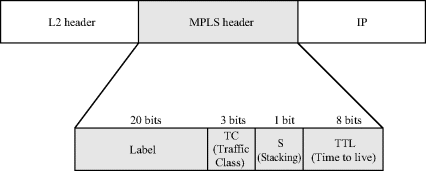4.7 MPLS/IP Applications
Multiprotocol Label Switching (MPLS) label is assigned between the L2 and L3 headers, making MPLS a ‘L2.5’ technology. Figure 4.27 shows MPLS protocol stack in an application of MPLS carrying IP and using Ethernet as the L2.
Figure 4.27 MPLS header.

MPLS header fields are Label, Traffic Class, Stacking, and Time-to-Live.
Twenty bits are used for the Label. With cell-mode MPLS, ATM VPI/VCI fields indicate the label. Similarly, frame relay DLCI information can be used for the label. In the subsequent text the focus is on frame mode MPLS with the 20-bit label as shown.
Traffic Class-field is used to mark Quality of Service. The field was originally marked as EXP – Experimental, although the three bits were used for QoS marking. Now the bits have been more correctly named in the IETF (RFC 5462) as Traffic Class.
S-stacking bit: This bit tells whether there are further labels in the stack to be processed.
TTL – time to live. Time-to-live field is used as in IP. The field can also be copied from the IP layer TTL field (TTL propagation). At the egress of the MPLS network, the outgoing IP packet should have a TTL value that is equal to the one it would have if it had traversed through the network without label switching.
The initial driver for MPLS was a need to speed up IP forwarding. When a label is assigned, forwarding decisions are done by examining this label, ...
Get Mobile Backhaul now with the O’Reilly learning platform.
O’Reilly members experience books, live events, courses curated by job role, and more from O’Reilly and nearly 200 top publishers.

